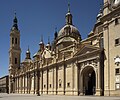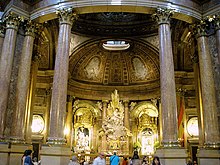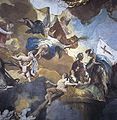Basílica del Pilar
The Basílica del Pilar (full name Catedral-basílica de Nuestra Señora del Pilar de Zaragoza , German mostly Basilica El Pilar ) is a Roman Catholic church in Saragossa , Aragon , Spain . It is the largest and one of the most important baroque churches in Spain and the co- cathedral of the Archdiocese of Saragossa . Her patronage goes back to a tradition according to which the Virgin Mary , the mother of Jesus, appeared to the apostle James the Elder on January 2nd of the year 40 AD on a pillar or pillar (Spanish pilar ). On this pillar is the miraculous image of Our Lady on the pillar . The Virgin Mary is the patron saint of " Hispanidad ", the feast of Our Lady on the Pillar on October 12th is also the national holiday in Spain .
history
Numerous churches have been built one after the other around the column. The first was a small chapel to keep the pillar. After the Reconquista of Zaragoza under King Alfonso I in 1118, a Romanesque church was built, which was damaged by fire in 1434. The church was rebuilt in the Gothic style with Mudejar elements . Today's baroque building goes back to extensions and alterations carried out between 1681 and 1754 according to plans by the architect Francisco Herrera Hidestrosa , who was appointed by a commission chaired by Juan de Austria . In its current form, the building is 130 m long, 67 m wide and has eleven domes. In addition to several bishops, General José de Palafox y Melci , the defender of Zaragoza during the Napoleonic Wars, rests in the church .
Furnishing
The rectangular building with four corner towers looks symmetrical from the outside, the interior is divided into a main nave with three domes and two aisles with four domes each. A clear orientation in the longitudinal direction only results from the Santa Capilla and the main altar and choir taken from the previous building.
The Santa Capilla forms a half-open space within the eastern part of the basilica, which Ventura Rodríguez added to the new building in 1725 . He chose an oval dome shape, which is broken upwards and is complemented by side half-domes. Since the structure is supported by four main pillars of the basilica, the walls are replaced by columns and access is possible from three sides, the altar forms the wall towards the interior of the church. In the center, a sculpture made of white marble and gilded bronze depicts the arrival of the Virgin Mary. To the left there is a group of seven people who, according to legend, had been converted by James the Elder before Mary appeared on a pillar to support him . This column is located on the right side of the chapel, but is also accessible to the faithful from the rear of the chapel. On it stands a small statue of the Virgin Mary made of gilded wood, which is surrounded by rich jewelry.
The altarpiece of the main altar combines the basic Gothic structure and formal elements in the upper area with sculptures in the Renaissance style in the middle and lower area. After Miguel Gilbert had been commissioned with the design in 1454, but died the following year, Damián Froment took over the commission in 1509 . In the center is the Assumption of Mary , on the left you can see a representation of Jesus in the temple and on the right the birth of the Virgin. Below is a row of seven wooden panels that still have remains of the originally colored painting. The oak choir stalls opposite were designed in the Plateresque style from 1544 to 1548 . In the upper row of the total of 124 seats, scenes from the Old and New Testament can be seen. A bronze grille by Tomas Selma from 1574 separates the choir stalls from the nave.
One element of the vaulted ceiling in the eastern part of the main nave opposite the Santa Capilla was decorated by Francisco de Goya in 1772 with the fresco The Adoration of the Name of God . This is Goya's first assignment in Saragossa after his return from Italy. In 1782 he decorated one of the domes of the north aisle with another fresco ( Regina Martyrum ). Two sketches for the work are exhibited in a showcase.
A curiosity within the Basílica del Pilar are two aerial bombs that are on display near the Santa Capilla . During the Spanish Civil War , early in the morning of August 3, 1936, a Republican plane bombed the Basílika. It dropped three bombs, but none of them exploded. One bomb fell a few yards from the basilica, another hit the roof, and the last hit near the Francisco de Goya mural . Believers attributed to the protection of the Virgin Mary that the bombs did not explode.
On October 2, 2013, several works of art in the church were slightly damaged when an explosive device detonated.
organ

The organ was built in 2007 by the German organ building company Klais in the existing historical organ case. The instrument has 71 stops on four manuals and a pedal . The game actions are mechanical, the stop actions are electric.
|
|
|
|||||||||||||||||||||||||||||||||||||||||||||||||||||||||||||||||||||||||||||||||||||||||||||||||||||||||||||||||||||||||||||||||||||||||||||||||||||||||||||||||||||||||||||||||||||||||||||||||||||||
|
|
|
||||||||||||||||||||||||||||||||||||||||||||||||||||||||||||||||||||||||||||||||||||||||||||||||||||||||||||||||||||||||||||||
-
Couple
- Normal coupling: II / I, III / I, III / II, IV / I, I / P, II / P, III / P, IV / P
- Sub-octave coupling: III / I, III / III
- Super octave coupling: III / I, III / III, III / P
Individual evidence
- ↑ For many: Regina Gade: “de mi invención”? Francisco de Goya in the service of the Spanish monarchy from 1775 to 1792 (= art history, vol. 85). Herbert Utz Verlag, Munich 2015, ISBN 978-3-8316-4485-8 , p. 73 u. Note 189.
- ↑ 24 horas : Artefacto explosivo estalla en plena basílica de Zaragoza (Spanish) of October 2, 2013
- ↑ More information about the organ .
Web links
Coordinates: 41 ° 39 ′ 25 " N , 0 ° 52 ′ 42" W.
















